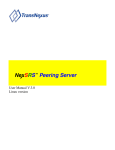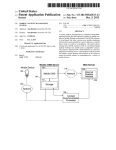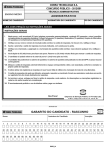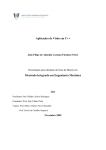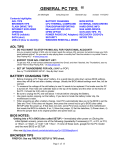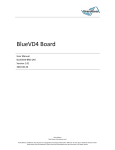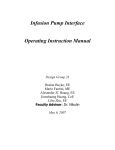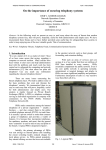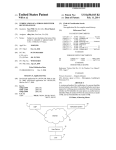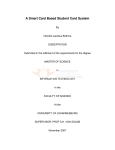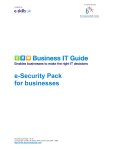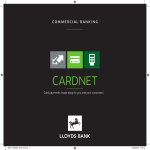Download из 1
Transcript
Czech Technical University in Prague
Faculty of Electrical Engineering
Master’s Thesis
2015
Nikulin Nikita
1
2
Czech Technical University in Prague
Faculty of Electrical Engineering
Department of Telecommunications Engineering
Billing system’s extension for fraud detection
2015
Author:
Supervisor:
3
Nikulin Nikita
Ing. Pavel Troller, CSc.
STATEMENT
I declare that this master’s thesis has been completed by myself with the assistance of
supervisor and consultant and only given literature has been. Further, I declare that I have no
objection to borrowing or disclosure of my master’s thesis or part of it.
Date: 11. 5. 2015
___________________
Signature
4
5
SUMMARY
This final project deals with creating of automated program for scanning billing data and
searching typical and untypical fraudulent traffic. Scripts are created in PHP using MySQL
database environment. First chapter of this project deals with general information about fraud and
methods of its detecting. Second chapter deals with created system’s extension including examples
of scanning and fraud detecting.
Index Terms:
Fraud detecting, detection of fraud, anti-fraud system
6
PLAN
INTRODUCTION ............................................................................................................. 8
1. ANALYTICAL PART ................................................................................................. 9
1.1. Fraud detection ............................................................................................................. 9
1.2. Voip fraud ................................................................................................................... 10
1.3. Types of voip fraud ..................................................................................................... 11
1.4. Techniques for fighting voip fraud ............................................................................... 18
1.5. Fraud detection solutions ............................................................................................ 19
2. PRACTICAL PART ................................................................................................. 20
2.1. Justification of creating the system’s extension .......................................................... 20
2.2. Minimal requirements for hardware and used software .............................................. 20
2.3. User manual ............................................................................................................... 23
2.4. Analyzing given database and detecting fraud ........................................................... 26
CONCLUSIONS ............................................................................................................ 28
REFERENCES .............................................................................................................. 29
7
INTRODUCTION
Fraud is a billion-dollar business and it is increasing every year. The PwC global economic
crime survey suggests that close to 30% of companies worldwide have reported being victims of
fraud in the past year.
Fraud involves one or more persons who intentionally act secretly to deprive another of
something of value, for their own benefit. Fraud is as old as humanity itself and can take an
unlimited variety of different forms. However, in recent years, the development of new
technologies has also provided further ways in which criminals may commit fraud. In addition to
that, business reengineering, reorganization or downsizing may weaken or eliminate control, while
new information systems may present additional opportunities to commit fraud.
Taking into account the rapid pace of development of IP-based technologies and the
increasing demands on the quality of communication the development of software tools for
scanning billing data and detecting fraudulent traffic is an urgent task.
8
1. ANALYTICAL PART
1.1. FRAUD DETECTION
Traditional methods of data analysis have long been used to detect fraud. 1They require
complex and time-consuming investigations that deal with different domains of knowledge like
financial, economics, business practices and law. Fraud often consists of many instances or
incidents involving repeated transgressions using the same method. Fraud instances can be similar
in content and appearance but usually are not identical.
The first industries to use data analysis techniques to prevent fraud were the telephony
companies, the insurance companies and the banks (Decker 1998). One early example of
successful implementation of data analysis techniques in the banking industry is the FICO Falcon
fraud assessment system, which is based on a neural network shell.
Retail industries also suffer from fraud at POS. Some supermarkets have started to make use
of digitized closed-circuit television (CCTV) together with POS data of most susceptible
transactions to fraud.
Internet transactions have recently raised big concerns, with some research showing that
internet transaction fraud is 12 times higher than in-store fraud.
Fraud that involves cell phones, insurance claims, tax return claims, credit card transactions
etc. represent significant problems for governments and businesses, but yet detecting and
preventing fraud is not a simple task. Fraud is an adaptive crime, so it needs special methods of
intelligent data analysis to detect and prevent it. These methods exists in the areas of Knowledge
Discovery in Databases (KDD), Data Mining, Machine Learning and Statistics. They offer
applicable and successful solutions in different areas of fraud crimes.
Techniques used for fraud detection fall into two primary classes: statistical techniques and
artificial intelligence. Examples of statistical data analysis techniques are:
• Data preprocessing techniques for detection, validation, error correction, and filling
up of missing or incorrect data.
• Calculation of various statistical parameters such as averages, quantiles, performance
metrics, probability distributions, and so on. For example, the averages may include
average length of call, average number of calls per month and average delays in bill
payment.
• Models and probability distributions of various business activities either in terms of
various parameters or probability distributions.
• Computing user profiles.
• Time-series analysis of time-dependent data.
• Clustering and classification to find patterns and associations among groups of data.
• Matching algorithms to detect anomalies in the behavior of transactions or users as
compared to previously known models and profiles. Techniques are also needed to
eliminate false alarms, estimate risks, and predict future of current transactions or
users.
1
WikiPedia
9
Some forensic accountants specialize in forensic analytics which is the procurement and
analysis of electronic data to reconstruct, detect, or otherwise support a claim of financial fraud.
The main steps in forensic analytics are (a) data collection, (b) data preparation, (c) data analysis,
and (d) reporting. For example, forensic analytics may be used to review an employee's purchasing
card activity to assess whether any of the purchases were diverted or divertible for personal use.
Forensic analytics might be used to review the invoicing activity for a vendor to identify fictitious
vendors, and these techniques might also be used by a franchisor to detect fraudulent or erroneous
sales reports by the franchisee in a franchising environment.
Fraud management is a knowledge-intensive activity. The main AI techniques used for fraud
management include:
• Data mining to classify, cluster, and segment the data and automatically find
associations and rules in the data that may signify interesting patterns, including
those related to fraud.
• Expert systems to encode expertise for detecting fraud in the form of rules.
• Pattern recognition to detect approximate classes, clusters, or patterns of suspicious
behavior either automatically (unsupervised) or to match given inputs.
• Machine learning techniques to automatically identify characteristics of fraud.
• Neural networks that can learn suspicious patterns from samples and used later to
detect them.
• Other techniques such as link analysis, Bayesian networks, decision theory, land
sequence matching are also used for fraud detection.
1.2. VOIP FRAUD
Voice over Internet protocol (VoIP) services transmit telephone calls over high-speed
Internet connections rather than over traditional land-based telephone lines. 2 They do not
usually travel directly from a caller to a recipient's computer but rather through computers
belonging to several layers of intermediary VoIP service providers, or wholesalers.
3
VoIP fraud is considered to be the use of a VoIP telecommunications network with the
intention of avoiding payment. In that sense, the payment may be incorrect, entirely lacking, or
the attempt to force another party to pay. We will consider both illegal activities and those
activities which, though technically legal, may still hurt telecommunications companies by
taking advantage of systems and vulnerabilities.
VoIP fraud can affect any organization which uses or sells VoIP services. In most cases,
the fraud target is an enterprise. Most enterprises never realize that they have been hacked,
refuse to pay the fraudulent charges and threaten to switch to a different service provider. The
SIP service provider has little leverage over its international long distance vendors and is left to
cover the bill.
However, in some cases, service providers will demand the enterprise pay for fraudulent
charges. This was the case in a 2009 when Michael Smith, a small business owner in
Massachusetts, found that someone had hacked into his PBX to make $900,000 worth of calls
2
3
TransNexus
The State of Phone Fraud: 1H 2012.
10
to Somalia. AT&T attempted to sue Smith for $1.15 million to recoup the cost of the calls and
interest. Though AT&T eventually dropped the charges, a spokeswoman for the company
maintained that they had been entitled by law to collect the amounts owed, and that Smith
should have put more safeguards in place to protect his phone system. 4
VoIP fraud can and does occur in any industry. Certain industries, such as banking, tend
to attract more fraud than others. A recent study from Pindrop Security found that nine out of
the top ten banks, and 34 of the top 50 banks had been victims of call fraud. 5
VoIP fraud comes from all over the globe. Traditionally, Africa has been a "Hot
Continent" from telecom fraud, because the termination costs are very high and regulation is
not as stringent as in other parts of the world. However, a 2011 study from the Communications
Fraud Control Association (CFCA) found that the top 5 countries from which fraud originates
are the United States, India, the United Kingdom, Pakistan, and the Philippines. The top five
fraud terminating countries were Cuba, Somalia, Sierra Leone, Zimbabwe, and Latvia. 6
VoIP fraud is a significant and growing problem in the telecommunications industry.
Because fraudsters often attack during weekends, fraud events often go undetected for many
hours. A single fraud event can easily cost a company between three and fifty thousand dollars.
In many cases, this number can be even larger. A 2009 attack on an Australian company's VoIP
PBX resulted in 11,000 international calls in just 46 hours, leaving the SIP provider with a bill
in excess of $120,000. 7 A 2011 weekend episode in South Africa resulted in a bill of over
$12,000 and another in the US cost victims more than $1.4 million. 8
Experts have trouble estimating an aggregated global yearly loss, because calculations are
often based on subjective and individual standards. However, most experts agree that total loss
is somewhere between 3 and 10 percent of income. This translates to a total global losses of
somewhere between 30 and 50 billion dollars per year. 9 The CFCA's 2011 report put the
number at $40.1 billion dollars lost.
This is a problem that is only increasing. According to the CFCA report, phone fraud is
growing at a rate of 29% per year. As the popularity of VoIP continues to grow, the problem of
VoIP fraud will become an increasing threat to the industry.
1.3. TYPES OF VOIP FRAUD
Fraudsters have come up with a myriad of techniques for exploiting the VoIP industry.
Some are stolen from traditional phone fraud tactics, others from computer hacking techniques,
and still others exploit VoIP specific equipment and software. These are just a few examples of
the many types of VoIP fraud and fraudsters are constantly coming up with new ways to attack.
In addition, most fraudsters will use some sort of combination of the techniques listed below.
4
AT&T Agrees to Drop $1.15M Suit against Phone Hacking Victim
The State of Phone Fraud: 1H 2012.
6
CFCA
7
Winterford
8
"VoIP Hacking on the Increase."
9
The Importance of Quantifying Fraud.
5
11
Arbitrage
Arbitrage is simply the exploitation of the differences in settlement rates between
countries, the complexity of services and rates, and the multi-operator environment of VoIP. For
example, if country A has much lower settlement rates with country B than with country C, it
might be cheaper for country C to send its traffic for country A via country B. One of the first
larger arbitrage routes was for traffic between Australia and the US, which was cheaper if sent
via New Zealand and Canada.
Pic 1. Arbitrage
This is an example of a type of fraud that falls into a legal gray area. Though it may seem
relatively tame, arbitrage can create problems for telecom companies. Unscrupulous providers
may artificially inflate traffic where arbitrage is profitable. Telcos often withhold payments to
Service Providers if this type of activity is suspected.
Buffer Overflow
Some VoIP fraud relies on methods typically used for computer fraud. In this case,
fraudsters use buffer overflow errors in handling INVITE or SIP (Session Initiation Protocol)
packets. The flaw might be used to crash applications or run arbitrary code. This is an issue that
has was a particular problem for Asterisk users in the past, but has since been remedied.
Bypass Fraud
Bypass fraud is the unauthorized insertion of traffic onto another carrier's network. You
may also find this type of fraud referred to as Interconnect fraud, GSM Gateway fraud, or SIM
Boxing. This scenario requires that the fraudsters have access to advanced technology, which is
capable of making international calls appear to be cheaper, domestic calls, effectively
"bypassing" the normal payment system for international calling. The fraudsters will typically
sell long distance calling cards overseas. When customers call the number on the cards,
operators are able to switch the call to make it seem like a domestic call.
12
Pic 2. Bypass fraud
Call Transfer Fraud
One type of fraud that has been a particular issue for softswitch users is call transfer fraud.
In this scenario, the fraudster hacks into a PBX and uses that PBX's services to make free long
distance calls. By instructing the compromised PBX to transfer the call to the hacker's own
phone service, subscribers to the fraudster's phone service can speak to their international
destinations through the hacked soft switch, and the soft switch operator cannot bill the hacker's
subscriber. Those familiar with three way calling will recognize the inspiration for this type of
fraud. See the chart below for a detailed explanation.
Pic 3. Call Transfer Fraud
13
1. Hacker phone service hacks unsuspecting PBX to make a call to make international
calls
2. PBX sends SIP INVITE to soft switch
3. Softswitch routes call to international carrier
4. Hacker instructs PBX to blind transfer call to Hacker Phone Service
5. PBX sends SIP REFER to soft switch to blind transfer call to Hacker Phone Service
6. Softswitch sends SIP INVITE to Hacker Phone Service
7. Hacker's Subscriber speaks to international destination through soft switch.
Most soft switches has no way of tracking a call once it is transferred out of the network,
so fraudsters can generate a significant amount of traffic and revenue for themselves before
being caught.
Domestic & International Revenue Share Fraud
Revenue share fraudulent activities are those which abuse carrier interconnect agreements.
Cooperation is the key to this type of fraud. The fraudster's goal is to pair up with a destination
that can charge high rates, and then inflate traffic to his numbers at little or no cost to himself.
These types of schemes can occur within a country, or across international borders. Though they
may not be technically illegal, they are often also paired with PBX hacking or other forms of
fraud that generate illegal and artificial traffic.
Fraud rings in the Philippines and other developing countries have been known to have
human "labor pools" that perform password guessing and make manual calls originating from
hacked PBXs. Sometimes the "labor pool" can even be generated by scams on social media,
SPAM mail, or post cards that advertise free vacations or important information just by calling
a phone number.
Traffic Pumping or Switch Access Stimulation
Because of telephone regulations, long distance carriers must pay access fees to local
exchange carriers for calls to those carriers' local subscribers. Rural carriers may charge
substantially higher access fees than urban carriers. In order to increase their incoming call
volume and revenue, some rural carriers partner with telephone service providers to route their
calls through the rural carrier. These often include phone sex or free conference call providers,
who expect a high volume of incoming calls. A similar scenario occurs internationally, with
fraudsters making setting up conference servers in third world countries and making deals with
the local (often state owned) telephone company.
To qualify as access stimulation, a fraudster must:
1. Have a revenue share agreement between the terminating carrier that stimulates
demand
2. Have a 3 to 1 increase in interstate terminating to originating traffic or 100% traffic
growth in a month year over year.
In this case, authorities can step in and force the terminating carrier to re-file their access
tariff with the public utilities commission within 45 days. Because of the extra traffic, the
14
terminating carrier would no longer be eligible for the high access fee, and will likely be
dropped from the revenue sharing agreement.
CNAM Revenue pumping or Dip pumping
Every call to a U.S. telephone number that has Caller ID (CID) enabled requires that the
terminating phone company perform a lookup in one of several national databases that contain
all the U.S. subscriber names and numbers. This database lookup is called a CNAM dip. When
this database is being 'dipped' the originating local phone company gets compensated by the
terminating phone company - this is commonly referred to as a CNAM dip fee (or simply a dip
fee). This compensation happens for every call where the calling party name is displayed to
the called party - even if the call is not answered.
CNAM Revenue Pumping, or DIP Pumping is similar to regular traffic pumping. The
fraudsters again, partner with the parties who typically receive CNAM revenue, and generate
traffic to conference servers with those numbers, sharing the revenue created. This traffic is
generated wither by high volume call services (such as free conference calls and phone sex
services) or by hacking into vulnerable PBX systems.
Premium Rate Services
Premium-rate telephone numbers are telephone numbers for telephone calls during
which certain services are provided, and for which prices higher than normal are charged.
Unlike a
normal call, part of the call charge is paid to the service provider, thus enabling businesses
to be funded via the calls. Like the other revenue sharing schemes, fraudsters will pair up with a
premium rate service to generate traffic to the number, via legal or illegal methods.
False Answer Supervision
When a dialed phone number is not in service, the calling party will hear a brief
recording telling them so. There is no answer supervision or connection between the calling
and called party. Since the call never connects, it is an incomplete call and should not be
billed. However, fraudsters use false answer supervision to make these calls appear as
completed calls which may be billed. Perhaps the fraudster has published rates for terminating
calls without any intention of actually completing the calls. Here, service providers will route
calls through the fraudster, who, instead of terminating the call, will play a not in service
message and then bill the service provider for more than 10 seconds of calling. This type of
fraud hurts the originating service provider both by costing money, and by hurting their
reputation. The key indicators of this type of fraud are:
•
•
•
Short phone calls
Calling party hangs up nearly 100% of the time
High answer seizure ratio
•
Location Routing Number (LRN) Fraud
Location Routing Number Fraud or LRN fraud works based on the desire of some service
providers to avoid extra charges from LRN "dips." Most providers will run an LRN dip to
15
determine the correct LRN for a dialed number. However, many service providers will not
perform an LRN dip if the LRN is already in the SIP message. Fraudsters take advantage of this
by inserting fake LRNs into their calls. For example, they may insert the LRN for a relatively
cheap terminating destination, when the call is actually going to a high cost rural destination.
The service provider will then bill the fraudster for the cheaper call, but will have to eat the cost
of the expensive rural call. In some cases, this can be up to 5x the price they billed the fraudster.
PBX Hacking
One of the most typical and certainly one of the most insidious flavors or VoIP fraud
involves hacking into a Private Branch Exchange (PBX). Fraudsters who can exploit the
vulnerabilities of the IP PBX are able to generate a significant amount of traffic. PBX hacking
is the common technique used to perpetrate the Domestic and International Revenue Share
Fraud and Call Transfer Fraud schemes listed above.
PBXs can be compromised in-band (over the phone circuit) by someone guessing the
numeric pin on an extension or by finding an extension with a default pin. There are four
common configuration mistakes in VoIP security architecture that can increase the risk of PBX
hacking: 10
1.
2.
3.
4.
Weak user authentication and access control
Relying solely on Session Border Controllers (SBCs) to provide security
Inadequate virtual LAN separation and control
Inadequate use of encryption
Phreaking
Phreaking is simply unauthorized access and control of a phone. Phreaked PBXs may be
networked together to create a fraudulent telecom network for providing services. Customers
of phreaked services often inclue call shops, call centers, calls sold through the internet, and
traffic pumping schemes.
Roaming Fraud
Roaming fraud is the use of a wireless operator's services outside of the user's "home
country" where there is no intention of paying for calls made. Typically, this type of fraud is
committed by someone who is also using subscription fraud (obtaining a service subscription
using a false identity). Because of the delay in the transference of call detail records between
roaming partners, it can take days or even weeks for the home network to receive the call
records and notice the fraud.
SIPVicious
Though its name suggests otherwise, the SIPVicious program is a mainstream auditing
too for VoIP systems. Unfortunately, fraudsters have also found a way to use it for attacks.
The attacks are apparently aimed at taking control of VoIP servers to place unauthorized calls.
The attacks use a known Trojan, jqs.exe, and connect to command and control servers to
10
Boone
16
receive instructions on downloading instructions as well as the SIPVicious tool from a .cc
domain. After installation, SIPVicious is run and scans for SIP devices on the compromised
computer's network and launches brute force attacks to guess the administrative password on
those systems. This creates a base from which attackers can make VoIP calls from the victim's
phone or VoIP infrastructure. Those calls might be used to rack up charges on premium rate
numbers controlled by the attackers, or as part of voice phishing (vishing) scams that target
unwitting consumers.
Shell Companies
Recent VoIP scams have involved the creation of "shell companies." These companies
have no operations, and their sole purpose is to induce companies that sell VoIP services to
extend service on credit to the shell companies. When the victim providers sell VoIP services
to the shell companies on credit, the conspirators "bust out" the accounts by causing the
companies to use substantially more VoIP services than the companies had been approved to
buy in such a short period of time. Fraudsters typically do this over weekends and holidays so
that the providers do not notice. When the invoices for the services came due, the fraudsters
send fake wire transfer confirmations via e-mail or submit small payments to keep the victim
providers from cutting off service.
Subscription Fraud
Subscription fraud is simple the use of service with no intent to pay. Often this type of
fraud is associated with other crimes, such as identity theft. The true impact of subscription
fraud often goes unrecognized because providers mistake it for bad debt. The key difference
between the two is intention. Fraudsters gain access to a service in one of three ways:
1. Giving valid details, but disappearing without paying the bill
2. Using false details
3. Using the identity of another person (identity theft)
Once recognized as a 'bona fide' customer, fraudsters then have access to a network and
are able to carry out revenue generating schemes that can seriously damage reputation and
bottom-line profits.
Toll Fraud
Toll fraud is a scheme where fraudsters break into a company's VoIP network and sell
long distance minutes. Fraudsters hack companies' PBXs, and then control the hacked PBXs
to make long distance calls. To make money, the fraudsters will sell long distance calls, and
then use the hacked PBXs to complete the calls.
Unallocated Number Fraud
Some fraudsters simply add unallocated phone numbers to their rate deck. They can then
simulate traffic to this number, which will generally be routed to the fraudulent company, as
they are the only ones that will "terminate" the call, based on the rate decks. According to
recent estimates, 32% of called numbers used for fraud are unallocated numbers.
17
1.4. TECHNIQUES FOR FIGHTING VOIP FRAUD
The most prevalent threats to VoIP deployments today are rooted in hacking of the
underlying and supporting infrastructure. The major IP PBX vendors can be secured, but
security has to be considered during deployments. It's important to consider your existing
network security before adding VoIP components. A VoIP security assessment and penetration
test will help identify vulnerabilities.
Analyzing Call Detail Records
The simplest way of tacking VoIP fraud is by analyzing Call Detail Records (CDRs).
VoIP providers should put into place a system that detects the most common symptoms of
fraud and PBX hacking, traffic spikes, unusual call patterns, etc. These systems work best
when they are reported in near real time. In addition, there must be a system for monitoring
this analysis, especially overnight, on weekends, and over holidays. The best analysis solutions
will include alerts or will be integrated with your routing system to temporarily block
suspicious calls.
Call Blocking
Some providers are taking an even more aggressive stance against fraud and completely
blocking destination countries with reportedly high incidences of fraud, or simply blocking
calls to fraud related phone numbers. Obviously, this method risks denying legitimate traffic,
and can also become a time consuming project, keeping up with the latest news on countries
and numbers that have been reported.
Call Routing
Other service providers have chosen to route fraud countries only through operators who
perform a validation on the call before completing it. Though this method may cut down on
fraud, it is also time consuming and not cost effective.
Legal Action
Though it is tempting to rely on legal action as a solution to VoIP fraud, it is not the ideal
option. Recent studies have shown that companies choose not to report fraud cases to law
enforcement due to a perceived lack of interest and understand from authorities. Though
89.1% of communications companies refer at least one case to law enforcement per year, few
fraudsters are ultimately caught and punished. 11
That being said, there have been recent arrests over VoIP fraud. In May 2012, two men
who stole more than $4.4 million from VoIP providers were sentenced to three years in prison
and will be required to pay back the millions of dollars. 12 In another recent case in Australia,
fraudsters were sentenced to 40 years in federal prison and owe $18 million in restitution. 13
11
12
13
2011 Global Fraud Loss Survey
U.S. Attorney's Office. District of New Jersey
Wilonsky
18
Session Border Controllers
Session Border Controllers, which work in front of an IP connected PBX can be a
deterrent to fraud. The SBC can detect and stop attempts to guess user credentials or
unauthorized attempts to route traffic. Some SBCs can analyze call patters and dynamically
learn your normal traffic patterns, sending warnings when something deviates from the norm.
Session Border Controller cannot, however, detect Traffic Pumping attacks.
1.5. FRAUD DETECTION SOLUTIONS
Alaris Anti Fraud System
The principle is that each network node that is able to provide relevant data to the fraud
management system is set to stream this data to the servers – by means of OS native utilities
(like rsyslog) or with the help of the agent – that is installed on the monitored nodes 14. The data
does not need to be transformed into any unified form, it can be in the original raw format.
The servers parse the data, index it, apply search algorithms to detect potential fraud and
send notifications to the client personnel in case of fraud detection events.
The search algorithms consist of the following principle stages:
•
identification of most common behavior templates (of an end-user, of a partner, of
a destination of the calls, etc.)
•
correction of the detected profiles by the end user
•
detection of non-standard behavior of objects (or on the contrary – detection of the
behavioral template of a fraud agent)
•
alarming the client on the detected fraud events
One of the most important things to mention is that the search algorithm is able to combine
events that are not linked to each other from the human point of view. For example: user selfregistration date, location, credit card type can be linked with the calls pattern generated by this
user, with the type of equipment used to generate calls, with the time frame during which the
calls are made.
Search Formula Sample
sourcetype=CDR*
type=CLI
|
stats
count
AS
Views,
count(eval(action="purchase")) as Purchases | eval percentage=round(100(Purchases/Views*100)) | count percentage AS "% Difference"
Such semi-self learning approach can be used to automatically detect new fraud events.
For situations when it is unknown what kind of fraud the network awaits – the system acts
the opposite way: all existing traffic is categorized and structured. Any behavior that deviates
from the known non-fraud patterns is marked as potentially fraudulent. The end user then
14
Alaris Anti Fraud System
19
decides whether a particular event is fraud or not. Based of that the system automatically creates
a “fraud” template and all new data is checked against this pattern as well.
TransNexus System
TransNexus has developed a number of solutions to detect fraud in VoIP
networks. 15NexOSS, in addition to its already industry-leading least cost routing features,
effectively eliminates the problem of traffic pumping fraud for VoIP providers. The solution is
to include smart monitoring features that sense when there is an unusual spike in call traffic to a
specific destination. When a suspicious spike occurs, the NexOSS system simply and
automatically puts a temporary block on the route, ensuring that fraud losses are kept to an
absolute minimum without interrupting legitimate calls.
TransNexus solutions analyze CDRs or RADIUS records, and can identify fraud by IP
address, or by group or user id.
2. PRACTICAL PART
2.1. JUSTIFICATION OF CREATING THE SYSTEM’S EXTENSION
VoIP is about convergence, saving money and resources. However, these types of systems
also create more inroads for attack. As VoIP has become more accessible and popular, security
threats have grown as well. The most prevalent threats to today's VoIP deployments are rooted in
traditional data networking and PSTN (public switched telephone network) attacks.
Today, VoIP devices are the primary tools used by fraudsters and 46% of fraudulent calls
were made from VoIP phones. That is why creating systems for scanning billing data and
detecting fraudulent traffic are on a priority basis.
2.2. MINIMAL REQUIREMENTS FOR HARDWARE AND USED SOFTWARE
Here are the minimal requirements for software are shown:
•
•
•
CPU 1GHz
RAM 512Mb
ОС Linux Red Hat Enterprise 3 update 4, ОС Windows XP or higher,
Recommended:
•
•
•
15
CPU 2x Xeon 3000
RAM 1024M
ОС Linux Red Hat Enterprise 3 update 4, ОС Windows 7
TransNexus
20
For creating the system following components have been used: XAMPP v3.2.1 which
includes Apache and MySQL modules, Dev-PHP v2.6.1 which includes module PHP v5.2.1
SQLyog Community – MySQL GUI v12.09 for creating MySQL databases, Google Chrome
v42.0.2 web browser and Bootstrap framework. Here are justifications of choosing particular
software are provided:
XAMPP
XAMPP is a free and open source cross-platform web server solution stack package,
consisting mainly of the Apache HTTP Server, MySQL database, and interpreters for scripts
written in the PHP and Perl programming languages. XAMPP also provides support for creating
and manipulating databases in MySQL and SQLite among others.
Once XAMPP is installed, it is possible to treat a localhost like a remote host by
connecting using an FTP client. Using a program like FileZilla has many advantages when
installing a content management system (CMS) like Joomla or WordPress. It is also possible to
connect to localhost via FTP with an HTML editor.
PHP
PHP is free software released under the PHP License 16. It is a server-side scripting
language designed for web development but also used as a general-purpose programming
language. PHP code can be simply mixed with HTML code, or it can be used in combination
with various templating engines and web frameworks. PHP code is usually processed by a PHP
interpreter, which is usually implemented as a web server's native module or a Common
Gateway Interface (CGI) executable. After the PHP code is interpreted and executed, the web
server sends resulting output to its client, usually in form of a part of the generated web page;
for example, PHP code can generate a web page's HTML code, an image, or some other data.
PHP has also evolved to include a command-line interface (CLI) capability and can be used in
standalone graphical applications. PHP includes various free and open-source libraries in its
source distribution, or uses them in resulting PHP binary builds. PHP is fundamentally an
Internet-aware system with built-in modules for accessing File Transfer Protocol (FTP) servers
and many database servers, including PostgreSQL, MySQL, Microsoft SQL Server and SQLite
(which is an embedded database), LDAP servers, and others. Numerous functions familiar to C
programmers, such as those in the stdio family, are available in standard PHP builds. There are
two primary ways for adding support for PHP to a web server – as a native web server module,
or as a CGI executable. PHP has a direct module interface called Server Application
Programming Interface (SAPI), which is supported by many web servers including Apache
HTTP Server, Microsoft IIS, Netscape (now defunct) and iPlanet.
16
PHP
21
MySQL
MySQL the world's second 17most widely used relational database management system
(RDBMS) and most widely used open-source RDBMS. MySQL is a popular choice of database
for use in web applications, and is a central component of the widely used LAMP open source
web application software stack (and other 'AMP' stacks). LAMP is an acronym for "Linux,
Apache, MySQL, Perl/PHP/Python." Free-software-open source projects that require a fullfeatured database management system often use MySQL.. It is a relational database
management system (RDBMS), and ships with no GUI tools to administer MySQL databases or
manage data contained within the databases. Users may use the included command line tools, or
use MySQL "front-ends", desktop software and web applications that create and manage
MySQL databases, build database structures, back up data, inspect status, and work with data
records. MySQL ships with many command line tools, from which the main interface is 'mysql'
client. MySQL works on many system platforms, including AIX, BSDi, FreeBSD, HP-UX,
eComStation, i5/OS, IRIX, Linux, OS X, Microsoft Windows and others. MySQL can also be
run on cloud computing platforms such as Amazon EC2.
Apache HTTP Server
The Apache HTTP Server, colloquially called Apache is the world's most widely used
web server software. This software is available for a wide variety of operating systems,
including Windows, OS X, Linux, Unix, FreeBSD and others. Apache supports a variety of
features, many implemented as compiled modules which extend the core functionality. These
can range from server-side programming language support to authentication schemes. Some
common language interfaces support Perl, Python, Tcl, and PHP. Popular authentication
modules include mod_access, mod_auth, mod_digest, and mod_auth_digest, the successor to
mod_digest. A sample of other features include Secure Sockets Layer and Transport Layer
Security support (mod_ssl), a proxy module (mod_proxy), a URL rewriter (mod_rewrite),
custom log files (mod_log_config), and filtering support (mod_include and mod_ext_filter).
Virtual hosting allows one Apache installation to serve many different Web sites. For example,
one machine with one Apache installation could simultaneously serve www.example.com,
www.example.org, test47.test-server.example.edu, etc. Apache features configurable error
messages, DBMS-based authentication databases, and content negotiation. It is also supported
by several graphical user interfaces (GUIs). It supports password authentication and digital
certificate authentication. Because the source code is freely available, anyone can adapt the
server for specific needs, and there is a large public library of Apache add-ons.
Google Chrome
Google Chrome is a freeware web browser developed by Google. As of January 2015,
StatCounter estimates that Google Chrome has a 51% worldwide usage share of web browsers
as a desktop browser. It is also the most popular browser on all the other platforms it supports,
mobile, tablets (except for the iPad where the Safari browser is preinstalled, and because of that
popularity Safari is most popular on all tablets combined) or any combinations of platforms,
such as mobile ("smartphones") plus tablets.
17
MySQL
22
Bootstrap (front-end framework)
Bootstrap is a free and open-source collection of tools for creating websites and web
applications. It contains HTML- and CSS-based design templates for typography, forms,
buttons, navigation and other interface components, as well as optional JavaScript extensions.
The bootstrap framework aims to ease web development. Bootstrap is a front end, that is an
interface between the user and the server-side code which resides on the "back end" or server.
And it is a web application framework, that is a software framework which is designed to
support the development of dynamic websites and web applications. Bootstrap is compatible
with the latest versions of the Google Chrome, Firefox, Internet Explorer, Opera, and Safari
browsers, although some of these browsers are not supported on all platforms.Since version 2.0
it also supports responsive web design. This means the layout of web pages adjusts
dynamically, taking into account the characteristics of the device used (desktop, tablet, mobile
phone). Bootstrap provides a set of stylesheets that provide basic style definitions for all key
HTML components. These provide a uniform, modern appearance for formatting text, tables
and form elements.
2.3. USER MANUAL
The system consist of three main sections and couple of subsections.
1) Database’s management
2) Manual section
2.1) Filter “Threshold”
2.2) Filter “Iteration”
3) Automatic section
3.1) Automatic filters management
3.2) Detailed report
3.3) Automatic send out of the report to user’s email address
Section “Database’s management” belongs to the button “Database” and represents data
from given database . Data can be filtered using parameters “Start Date”, “Stop Date” and
“Phone Number” for both originating (orig) and terminating (term) numbers. Changing “Limit
of rows” can be set represented rows of data.
Important information:
1) All fields of parameters should be always filled
2) Parameters “Start Date” and “Stop Date” should be always set in format YYYY-MMDD HH:MM:SS
3) One of the parameters “Originating”/ “Terminating” should be always chosen if they
are belong to particular section.
23
Pic 4. Database’s management
Manual section was created for manual checking data from the database using particular
parameters.
Filter “Threshold” belongs to the button “Threshold” and can be used for filtering data
from the database by parameters “Total amount of calls”, “Total duration” and “Minimal
amount of zero calls” for both originating (orig) and terminating (term) numbers.
Pic 5. Filter “Threshold”
Filter “Iteration” belongs to the button “Iteration” and created for scanning database for
specific events when caller tries to call to any numbers in series. In other words orig number
“9635013013” calls to “963452129314”, then to “963452129316”, then to “963452129311” and
this is a symptom of fraud. Parameter “Minimal amount of iterations” regulates amount for such
numbers.
24
Pic 6. Filter “Iteration”
Section “Automatic” belongs to the button “Automatic” and allows user to create set of
filters for automatic procedure of checking database according to the set filters and its parameters.
Every filter in set has its own parameters for set destinations.
Pic 7. Section “Automatic”
There are 2 more buttons belong to section “Automatic” – button “Detailed report” which
represents detailed report of filtered database according to set filters and button “Email Report”
which sends report to user’s email address.
Function “Email Report” was specially created for demonstrating the project and will be
replaced by cronjob when script will be connected to real database in real-time regime. It will
allow to check database accordingly with set of filters and send report to user’s email every time
when filters are actuated which means that fraudulent activity is detected.
25
2.4. ANALYZING GIVEN DATABASE AND DETECTING FRAUD
Analyzing given database using manual filter “Threshold” for period of 1 day below data is
received:
Pic 8. Analysis using filter “Threshold” for period of 1 day
As it shown above the numbers 963509923 and 963509932 has big amount of calling
attempts and more them 80% of them are zero calls. It is a symptom of fraud as well as wrong
routing or non-working destination. In any case this information is important for the user and
should be sent to him. In “Automatic” section for Syria destinations for period of one day we set
filter “Threshold” and will get reports about such activity in future automatically.
Next analyzing using manual filter “Threshold” for destination Syria for weekend period by
parameter “Duration” below data is received:
Pic 9. Analysis using filter “Threshold” for Syria for weekend
As it shown above callers from Syria are very active during weekend period. And it is a
symptom of fraud and should be investigated by user. In “Automatic” section for Syria
destinations for weekend period we set filter “Duration”.
Next analyzing all destinations using manual filter “Threshold” for whole period below data
is received:
26
Pic 10. Analysis using filter “Threshold” for whole period
As it shown above 2 numbers 9635013013 and 9635013011 has big amount of calling
attempts and more them 80% of them are zero calls. Will set filter for these 2 numbers in section
“Automatic”.
Next analyzing all destinations using manual filter “Iteration” for whole period below data is
received:
Pic 11. Analysis using filter “Iteration” for whole period
As it shown above there were a lot of calls from Syria to numbers in series and it is fraud.
Let us set filter “Iteration” for destination Syria in “Automatic” section to get to know if it again
happen in future.
Using set of filters according to above parameters user will get following report on his email:
Pic 12. Automatic report about detected fraud
27
CONCLUSIONS
VoIP providers and enterprises must work together to ensure their networks are secure
from every angle. By securing networks and analyzing traffic for signs of fraud, VoIP
providers can minimize their fraud risks.
VoIP fraud is, and will remain, a lucrative criminal business. As VoIP continues to grow
in popularity, schemes for beating the system will continue to become more complex and
powerful.
To prevent any fraudulent activity current system extension has been created including
possibility of filtering data taking into account all necessary parameters, creating detailed
reports in accordance with set filters and possibility of automatic signaling to user about any
fraudulent activity detecting. System has been tested using autonomous database but can be
easily implemented in working billing system. Possibility of improving system extension for
making it automatically change routings and block destinations according to results of
automatic analysis was implemented as well.
28
REFERENCES
[1] Wikipedia, the free encyclopedia. Data analysis techniques for fraud detection
<http://en.wikipedia.org/wiki/Data_analysis_techniques_for_fraud_detection>.
[2] TransNexus Solutions. Fraud Detection
<http://transnexus.com/solutions/fraud-detection/>.
[3] The State of Phone Fraud: 1H 2012. Rep. Pindrop Security, 2 Aug. 2012. Web. 10
Sept. 2012.
<http://www.cfca.org/pdf/whitepapers/wp_pindrop_phonefraudreport.pdf>.
[4] AT&T Agrees to Drop $1.15M Suit against Phone Hacking Victim. CFCA, 10 July
2012. Web. 10 Sept. 2012.
<http://www.cfca.org/fraudalert.php ?id=5232>.
[5] The State of Phone Fraud: 1H 2012. Rep. Pindrop Security, 2 Aug. 2012. Web. 10
Sept. 2012.
<http://www.cfca.org/pdf/whitepapers/wp_pindrop_phonefraudreport.pdf>.
[6] CFCA. Communication Fraud Control Association (CFCA) Announces Results of
Worldwide Telecom Fraud Survey. CFCA. CFCA, 4 Oct. 2011. Web. 10 Sept. 2012.
<http://www.cfca.org/pdf/survey/CFCA2011GlobalFraudLossSurvey-pressrelease.pdf>.
[7] Winterford, Brett. "Perth Firms Phreakedby VoIP Hackers."ITnews. N.p., 12 Apr.
2011. Web. 10Sept. 2012.
<http://www.itnews.com.au/News/254255,perth-firms-phreaked-by-voip-hackers.aspx>.
[8] "VoIP Hacking on the Increase." My Broadband. N.p., 9 May 2011. Web. 10
Sept.2012.
<http://mybroadband.co.za/news/telecoms/20140-voip-hacking-on-the-increase.html>.
[9] AT&T Agrees to Drop $1.15M Suit against Phone Hacking Victim. CFCA, 10 July
2012. Web. 10 Sept. 2012.
<http://www.cfca.org/fraudalert.php ?id=5232>.
[10] Boone, Adam. "Toll Fraud Is Alive and Well." Computerworld. N.p., 2 Oct. 2009.
Web. 10 Sept. 2012.
<http://www.computerworld.com/s/article/9138803/Toll_fraud_is_alive_and_well>.
[11] 2011 Global Fraud Loss Survey. Rep. CFCA, 4 Oct. 2011. Web. 10 Sept. 2012.
<http://www.cfca.org/pdf/survey/CFCAGlobalFraudLossSurvey2011.pdf>.
[12] U.S. Attorney's Office. District of New Jersey. Two Fraudulent Telephone Service
Wholesalers Sentenced to Prison for $4.4 Million VoIP Fraud Scheme. FBI. N.p., 15 May
2012. Web. 10 Sept. 2012.
<http://www.fbi.gov/newark/press-releases/2012/two-fraudulent-telephone-servicewholesalers- sentenced-to-prison-for-4.4-million-voip-fraud-scheme>.
29
[13] Wilonsky, Robert. "Three Ringleaders of Local "cybercrime Conspiracy" given
Long Prison Sentences, Forced to Pay Back Many Millions." Web log post. Crime Blog.
Dallas News, 25 May 2012. Web. 10 Sept. 2012.
<http://crimeblog.dallasnews.com/2012/05/three-ringleaders-of-local-cybercrime-conspiracygiven-long-prison-sentences-forced-to-pay-back-many-millions.html>.
[14] Alaris Solutions. Alaris Anti Fraud System
<http://alarislabs.com/solutions/anti-fraud/>.
[15] TransNexus Solutions. Fraud Detection
<http://transnexus.com/solutions/fraud-detection/>.
[16] PHP
<https://en.wikipedia.org/wiki/PHP >.
[17] MySQL
<https://en.wikipedia.org/wiki/MySQL >.
30






























